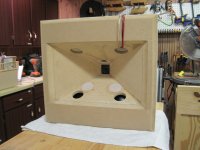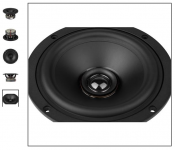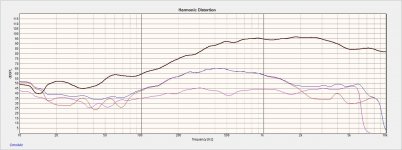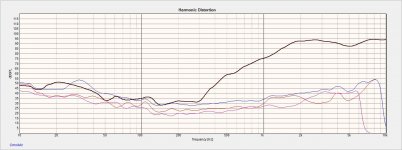The THD graphs from BMS are quite hard to read in that they do not have a vertical scale listed so you have to guess. The level has also been raised by 10 or 20dB as indicated on the graph which isn't so helpful either. The thing that is good on those is how much lower the 3rd order THD is compared to the 2nd.
Yes, it is really strange that they don't give you the vertical scale. I assumed 10dB for all graphs.. Who knows if that is correct. The 3rd order thing is also strange, since most of the time they don't even show up.. which is good I suppose
Patrick/John, I was googling to find sources and prices for the SB65 (about $30 per it seems), and also ran into this. Have you by chance tried it? 2", a spacer ring in front, a (suspiciously) good response curve, relatively inexpensive...
Amazon.com: DROK Micro 12W Stereo Audio Speaker 2" inch 4 Ohm Full Range Speaker 2.0/2.1 Hifi DIY Loudspeaker Woofer Active Light Speaker Indoor External Usage Auto Car Motor Motorcycle: Industrial & Scientific


Amazon.com: DROK Micro 12W Stereo Audio Speaker 2" inch 4 Ohm Full Range Speaker 2.0/2.1 Hifi DIY Loudspeaker Woofer Active Light Speaker Indoor External Usage Auto Car Motor Motorcycle: Industrial & Scientific


Chances are in home , even in a home theater, you will operate at least 12 db below the 122.6 db maximum and at that level you will have acceptably low distortion and have > 10 db advantage over the SB65. I think I would want the HF-148 or similar in my HT but the the SB65 would do well in a system for my home office.
I agree with your thoughts in general and the SPL's seem about right, my point was you need to view the whole system in general. It is pointless having a CD that can do 130dB if your woofers tap out at 99. The SB65 works nicely with the woofers used in Bushmeisters design and it is the woofers that are the limiting factor to SPL.
Your design is different and considerably bigger so you have the low output potential. It wouldn't make sense to use a volume limited HF unit for you.
Home theatre is a very different situation to music. Everyone's listening volumes will be different so you need to pick based on what you want to use it for.
Both methods are totally valid and can coexist nicely, pick the approach that suits your situation the best.
It's funny that this thread has now headed towards "How to avoid using a midrange"
Do you have any distortion measurements of the XT tweeter in your horn? I have seen a lot of conflicting information on how low it's possible to cross the XT25 before distortion is an issue.Here are a few tweeter measurements in a synergy horn foam core model. My plan was to use the RS28A until it went NLA. I'm currently using the XT25TG30.
I don't have in horn distortion measurements of the XT yet.
I'm working on a preliminary passive x-o for the prototype. I'm expecting to cross near 1,500 hz.
The attachments are the xt in horn with the mid hole covered and a picture of the prototype.
I'm working on a preliminary passive x-o for the prototype. I'm expecting to cross near 1,500 hz.
The attachments are the xt in horn with the mid hole covered and a picture of the prototype.
Attachments
So I've been considering the Synergy concept for an electric guitar monitoring application where high frequency flat response is only needed or even desireable to 10khz and LF response to 100hz. Given the passband, a two way Synergy makes sense to me with a 2" CD at the throat. What size midwoofer drivers would you guys propose with high SPL and high efficiency properties? Size constraints would be somewhere in the realm of 24" x 20" face and a depth of around 16".
Last edited:
Think i could get 4 8FE200's in there? Having the highest efficiency possible would allow me to drive this with a low watt tube power amp which is the goal. The pupose of these monitors will be for stage use with DSP driven modeling pre amplifiers and imported impulse responses to simulate actual guitar speaker cabinets. I don't want to add another veil of solid state amplification and DSP, yet the tube power section to smooth the digital sound character of the modeler.
What inexpensive 2" would you suggest? I've had my eye on the new one from Eminence Eminence N320T-8 2" Neo Compression Driver 8 Ohm 4-Bolt
What inexpensive 2" would you suggest? I've had my eye on the new one from Eminence Eminence N320T-8 2" Neo Compression Driver 8 Ohm 4-Bolt
Look in Cask05's kit thread for CD recommendations; I don't have the hands on to say.
With 2 drivers on each H flare or V flare, no problem fitting 4 drivers. Try to put on driver on each of the four flares and things can get crowded together up near the throat but potentially still can be done given the low XO possible with a 2" CD.
With 2 drivers on each H flare or V flare, no problem fitting 4 drivers. Try to put on driver on each of the four flares and things can get crowded together up near the throat but potentially still can be done given the low XO possible with a 2" CD.
https://www.parts-express.com/dayton-audio-cx150-8-5-1-4-coaxial-driver-with-1-silk-dome-tweeter-8-ohm--295-386
I wonder how this one would do in a Synergy (the ones like Danley does with a single coax driver, tweeter coupled to the throat, woofer output entering up further toward the mouth)?
I wonder how this one would do in a Synergy (the ones like Danley does with a single coax driver, tweeter coupled to the throat, woofer output entering up further toward the mouth)?
Attachments
It doesn't model well. Looks like PE will be pulling back as the former has vent holes. thread here Dayton Coaxial w/Silk Dome - Techtalk Speaker Building, Audio, Video Discussion Forum
I wonder how this one would do in a Synergy (the ones like Danley does with a single coax driver, tweeter coupled to the throat, woofer output entering up further toward the mouth)?
I think the ones that do the best are those like the B&C 6fhx51 that have a waveguide in front of the woofer cone. All you have to do is replace that waveguide with a larger, 3D printed one and you have your Synergy.

Look in Cask05's kit thread for CD recommendations; I don't have the hands on to say.
With 2 drivers on each H flare or V flare, no problem fitting 4 drivers. Try to put on driver on each of the four flares and things can get crowded together up near the throat but potentially still can be done given the low XO possible with a 2" CD.
It looks like the Eminence Neo 2" CD will hold up to a 700hz cross to the midwoofers which would give me 5" to work with from the exits to the throats of the CD. Gotta lay it out and see if it can be done. Two 12" woofers might be easier and still have the efficiency and power handling to get the job done.
Do you have any distortion measurements of the XT tweeter in your horn? I have seen a lot of conflicting information on how low it's possible to cross the XT25 before distortion is an issue.
Distortion measurements of the xt25tg30 in the horn. One with the x-o and one without the x-o.
Attachments
The x-o is L-R 4th order with L-pad. I'm working on adding some shaping to the response before I call it done (passive x-o).
A few things I've noticed on the conventional tweeter was that a square entry was better than round, and getting close to the dome by overlapping the edge of the tweeter surround is beneficial.
A few things I've noticed on the conventional tweeter was that a square entry was better than round, and getting close to the dome by overlapping the edge of the tweeter surround is beneficial.
With a square sided opening over a round tweeter opening, I wouldn't consider it a chamber, although I'm sure there are reflections. In post #2149 you can see the extent of the overlap. That's a 40 mm square over a 45 mm tweeter circle
I think the key learning for me was to not force a smooth transition from the tweeter opening to the horn
I think the key learning for me was to not force a smooth transition from the tweeter opening to the horn
- Home
- Loudspeakers
- Multi-Way
- Suitable midrange cone, for bandpass mid in Unity horn.




